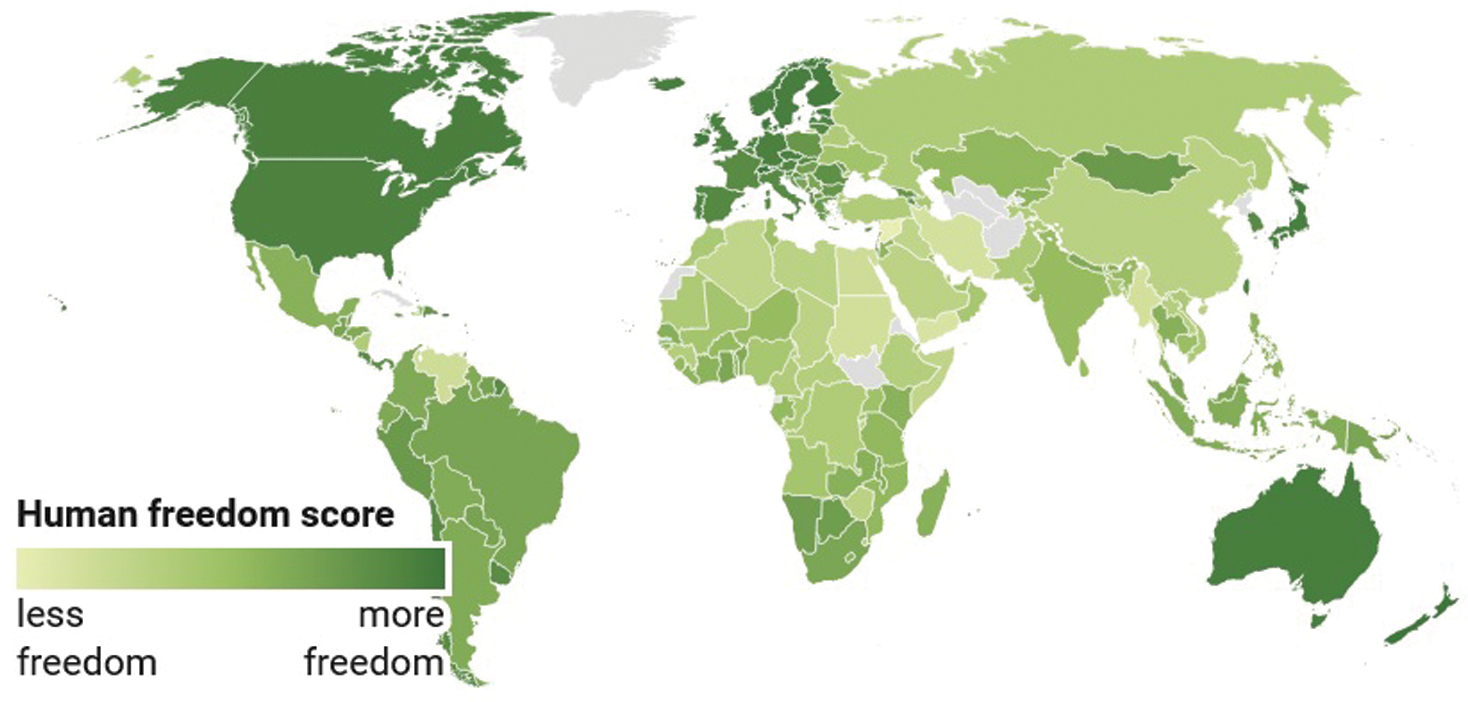US Freedom Level Drops
By Ian Vásquez
The United States has slipped in its ranking as a free country from 7th in 2000 to 17th in the tenth edition of the annual Human Freedom Index, which is co-published by the Cato Institute and the Fraser Institute. The 2024 report paints a picture of the state of global freedom and freedom within 165 countries, drawing on 86 indicators of personal, economic, and civil liberties dating back to the year 2000.
The top three countries in this year’s report are Switzerland, New Zealand, and Denmark; the bottom three are Iran, Yemen, and Syria, in descending order.
Compared to 2007, most countries are less free, having lost a significant amount of economic or personal freedom or both.
The high point in global human freedom since 2000, measured on a population-weighted basis, occurred in 2005–2007. It was followed by a slow decline in the aftermath of the global financial crisis and then a precipitous decline in 2020 with the outbreak of the coronavirus pandemic, setting any gains to global freedom back more than two decades. Global freedom saw a small improvement in the third year of the pandemic, 2022, the last year of the report.
Writing about the report, Ian Vásquez of the Cato Institute, said, “The index reflects our belief that freedom should be measured carefully because it has inherent value and because it plays a central role in human progress. We define freedom as the absence of coercive constraint and think of it as a social concept that recognizes the dignity of the individual.”
* Human freedom is strongly and positively related to well-being, including income, innovation, social tolerance, environmental performance, levels of charity, life expectancy, lower child mortality, etc.
* Economic and personal freedom are strongly related. If you value high levels of personal liberty (such as freedom of expression, religion, or personal lifestyle choices), you should value a relatively high level of economic freedom, which is supportive of the other freedoms.
* The world suffers from a high degree of inequality in freedom. Only 14.1% of the world’s population lives in the top quartile of countries in the index. Fully 77% of the world’s population lives in the least free countries in the bottom half of the index.
Nicaragua, Syria, Turkey, Hong Kong, and Hungary are among the top ten jurisdictions that have seen their freedoms decline most since 2007, the year that marked the high point in global freedom.
Out of ten regions, the Middle East and North Africa are the least free and are some of the regions that saw their freedom fall since 2000.
Global freedom of expression has been on a long-term decline since 2000 and is the category of freedom that saw the greatest drop since that year.
Human freedom deteriorated severely in the wake of the coronavirus pandemic. Most areas of freedom fell, including significant declines through 2022 in freedom of movement, expression, and association and assembly; and in sound money. After having fallen significantly in 2020 and further in 2021, human freedom increased in 2022 but remained well below its pre-pandemic level during the third year of the pandemic. On a scale of 0 to 10, where 10 represents more freedom, the average human freedom rating for 165 jurisdictions fell from 6.98 in 2019 to 6.76 in 2020 and to 6.73 in 2021, and then increased in 2022 to 6.82. On the basis of that coverage, 87.4 percent of the world’s population saw a fall in human freedom from 2019 to 2022, with many more jurisdictions decreasing (130) than increasing (28) their ratings and 7 remaining unchanged. The sharp decline in freedom that began in 2020 comes after years of slow descent following a high point in 2007. In the third year of the pandemic, global freedom remained at a level far below what it was in 2000.
The data show that there is an unequal distribution of freedom in the world, with only 14.1 percent of the world’s population living in the top quartile of jurisdictions in the HFI and 43 percent living in the bottom quartile.
The countries that took the top 10 places, in order, were Switzerland, New Zealand, Denmark, Luxembourg, Ireland, Finland, Australia and Iceland and Sweden (tied at 7), and Estonia. Selected jurisdictions rank as follows: Canada (11), Japan (12), Germany (14), United Kingdom and United States (tied at 17), Taiwan (19), Chile (31), South Korea (32), France (34), Brazil (70), South Africa (73), Argentina (80), Mexico (94), India (110), Ukraine (122), Nigeria (126), Russia (139), Turkey (142), China (150), Saudi Arabia (155), Venezuela (159), and Iran (163). Out of 10 regions, those with the highest levels of freedom are North America (Canada and the United States), Western Europe, and Oceania. The lowest levels are in the Middle East and North Africa, sub-Saharan Africa, and South Asia. Women-specific freedoms, as measured by five indicators in the index, are strongest in North America, Western Europe, and East Asia and are least protected in the Middle East and North Africa, sub-Saharan Africa, and South Asia.
There is a strong relationship between freedom and median and per capita income. Jurisdictions in the top quartile of freedom enjoy a significantly higher average per capita income ($56,366) than those in other quartiles; the average per capita income in the least free quartile is $15,826. The HFI also finds a strong, positive relationship between human freedom and democracy, and between human freedom and a range of human well-being indicators including tolerance, charitable giving, life expectancy, and environmental health, among other measures.


0 comments